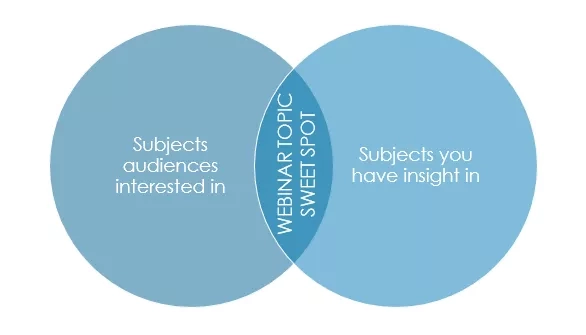Webinars are a fantastic way to connect with your target audience. As with all events, they offer a real opportunity to get under the skin of your audience and create a long-lasting connection between your brand and your audience in a way many other marketing channels struggle to achieve.
Webinar technology has come a long way, and now offers a wealth of ways for those running them to present and those participating to interact. But even with the greatest technology in the world, the core of a winning webinar is, of course, its topic. As we’ve said webinars are a fantastic marketing channel… and just as with any other marketing, content is king. So, how do you make webinars engaging in 2024?
Thought Leadership First
So, you’ve recognized the vast benefits that webinars could bring you, perhaps you’ve even identified the technology you’ll use to run them…but, what are you going to talk about?
When thinking about your topics, start by considering your webinars as a form of thought leadership, rather than solely a sales channel. Keeping this in mind will shift your focus on topics from “this is what we do/sell” to “this is how we can help you.” And while some might say this is a subtle difference, it means that you can correctly set your webinar’s objectives.
We’d recommend that instead of setting a target number of post-webinar sales, you should focus on brand building, demonstrating your expertise, and developing relationships with your audience. To do that, you'll need to develop engaging webinar ideas.
When starting from the position of thought leadership, your webinar may (or may not) provide some “immediate” sales, but beyond this, the longer-lasting effect will be that you’ll be remembered as the experts at the point your service offering comes to mind…which will usually be when your audience, or someone they know, have a need for your product or service. By focusing on thought leadership, you can elevate your webinars and create something that people truly look forward to and engage with. Such association with your brand will be invaluable.
How to Be a Thought Leader
It’s easy to say “be a thought leader” but it perhaps sounds like a daunting prospect to those just starting out. When you boil it down, thought leadership is about demonstrating your expertise and – importantly – your opinion.
With this in mind, in order to make webinars engaging, you should consider subjects that your target audience would be interested in finding out about, and which you have the insight and authority to inform them about. You can consider it as something like a Venn diagram:
Predominantly, you’ll find that the overlap presents you with topics about current or future trends in your industry. One thing that you’ll definitely need in order to provide authentic thought leadership is a strong opinion.
BYO Opinion
One key part of making webinars engaging is by ensuring that they demonstrate your opinion. Rather than simply regurgitating stats and facts (regardless of how important or impressive they sound) giving your own views on them is so much more powerful. Now we’re not saying you shouldn’t use research and statistics, but the best webinars aren’t factual lectures. Instead, they’re an opportunity to bring your own ideas to life and a fantastic platform to demonstrate your insight and expectations of the future.
A good webinar needs to tell a good story. While statistics from either first-hand research or research bodies recognized in your industry are nice to have, they’re far from a whole narrative. They are simply your scene-setters – your interpretation of them will tell the real story your audience will engage with. Bring statistics to life by deciding what you really think of them; why are they important, what do they tell you, and how might your interpretation be different from others?
When considering the sort of factual information you’re intending to use, hold each up against your webinar’s objective to see whether it helps drive the narrative toward that goal.
And don’t be afraid to be bold. If your opinion differs wildly from others in your industry, all the better. If you can tell a compelling story and demonstrate why you think differently, then you’ll stand apart from your competitors who are also vying for the attention of your audience, and you’ll remain much more memorable.
Brainstorm
So, you know that your core objective is going to be building your brand by demonstrating your expertise and knowledge. And you know in order to do that you need to be original and have an opinion… that’s a good start.
With this in mind, it’s time to begin gathering ideas for your webinar topic. A brainstorming exercise is a great place to start. If you’re able to run a session with your team, then even better, as you’ll be able to bounce ideas around and potentially come up with many more options.
The first thing you’ll want to do is aim for quantity. If you start focusing on one single topic too soon, you may stop short, interrupt creative thinking and miss something better. So simply discuss all options and jot everything down - start with the mantra that no idea is a bad idea and you’ll find that you end up with a big list of potential topics for your webinar. This is great for two reasons:
- Firstly, you’ll have enough webinar topics to choose from for now and for the future, so you could easily plan out a whole webinar series.
- And secondly, by thinking big and silencing the “we couldn’t do that” voice, you may well come up with something genuinely amazing that could really stand out and give your audience something truly memorable.
By allowing yourself time to really think about your potential topic, you’ll also likely come up with several topics that could be combined into a single webinar with a stronger message. Ensuring you give yourself space and dedicated time for topic brainstorming is a crucial step.
Refine Your Options
Once you have your big list, it’s then a case of looking at each of your wild ideas with a critical eye and considering what your position would be on each; in which of them do you have the expertise, research, or factual basis AND (as we’ve labored above) a strong, original opinion? At the same time, consider which of your topics your audience would be genuinely interested in (remember the Venn diagram?!)
If you wanted to get scientific about it, you could rank your options and ask your colleagues to do the same with these criteria in mind. You might consider using something as straightforward as a spreadsheet, with one column for the topic, one for your knowledge/expertise, one for whether you have strong opinions, and one for anticipated audience interest.
You could then rank each from one to five (with five being the highest) and ask your colleagues to do the same. Once you’ve gathered your responses, add up your totals and whichever topics have the highest score should be your primary consideration.
5 Webinar Secrets that Guarantee Success
See the above subtitle? That’s an example of one way to create a real buzz around your webinar. To drive interest and get plenty of sign-ups, you need to demonstrate how your webinar will deliver genuine value.
Often this means providing just enough information to intrigue audiences with a promise of learning something really worthwhile. In online terms, this might be called clickbait, but the important thing to ensure is that unlike so much online clickbait (and the reason for the term’s less-than-shining reputation), your promise is genuine. Don’t promise tips that aren’t genuinely insightful. And certainly don’t offer up a solution that’s simply “buy our stuff.” That’s not going to leave a very good impression on your audience as they may feel cheated or lied to. Remember, it’s about thought leadership and brand building, not a direct sales channel.
So, when considering your topic, make sure you can identify what it is the audience will be gaining – what value they will get from taking part. Then use that to provide that hook to get people signed up. And while we’re talking about hooks, numbered lists are a really great tactic to consider (“3 top tips…” “7 steps to…” and so on). They’re easy to understand, set clear expectations, and can provide a useful structure to follow when developing your content.
Make Webinars Engaging: Next Steps
Choosing the right topic is fundamental for getting the most out of your webinars. Once you’ve chosen your subject matter, your next task is deciding how you’re going to present and discuss it in the most effective, compelling way possible.
You’ll also need to choose a platform to use to run your webinar; one that has all the features and functionality you might need. Choosing the right solution will give you everything in one place to drive as much value out of your webinars as possible. From simple registration and customization to a range of interactivity options, trackable CTAs, real-time actionable data, and much more.
Our comprehensive webinar software can bring your topic to life and ensure it becomes a truly memorable experience for the audience.







